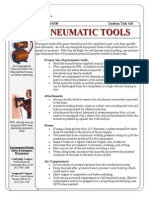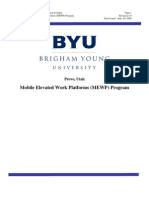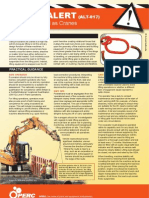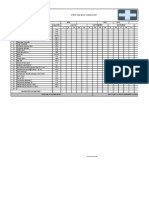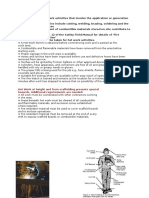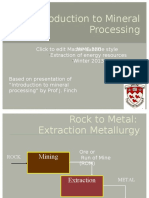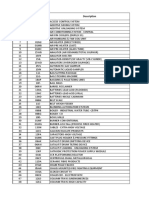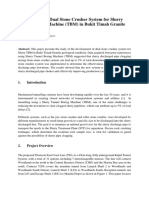Safe Operation and Use of Mobile Jaw Crushers
Safe Operation and Use of Mobile Jaw Crushers
Uploaded by
テレブリコ ジェファーソンCopyright:
Available Formats
Safe Operation and Use of Mobile Jaw Crushers
Safe Operation and Use of Mobile Jaw Crushers
Uploaded by
テレブリコ ジェファーソンCopyright
Available Formats
Share this document
Did you find this document useful?
Is this content inappropriate?
Copyright:
Available Formats
Safe Operation and Use of Mobile Jaw Crushers
Safe Operation and Use of Mobile Jaw Crushers
Uploaded by
テレブリコ ジェファーソンCopyright:
Available Formats
Safe operation and use of mobile jaw
crushers
Scope of this guidance
Mobile crushers are used in a wide range of industries, including quarrying, ore processing and recycling
of demolition waste. This guidance is for all those with responsibilities for the operation of mobile
crushers, including contract managers, supervisory staff and operators of these machines. It covers the
safe operation of the mobile crushing operation and includes guidance on clearing blocked crushers.
This guidance cannot cover every risk and is not comprehensive. It does not attempt to detail individual
machinery safety concerns, but will only highlight those key matters of concern.
The risks associated with your particular operation, and the methods of reducing those risks, should be
revealed during your risk assessment.
Key risks
Machinery guarding
Clearing Blocked or Stalled Crushers
Slips and trips
Transport coming in to contact with excavators loading the crusher
Mobile crushers are versatile pieces of equipment with many uses. A properly planned operation will be
efficient, safe and productive. A poorly planned operation will be unproductive, dangerous and inefficient.
These machines can, and have, killed.
Typical layouts
Mobile crushers will normally be fed from loading shovels, backhoe excavators or from other processing
machinery (e.g. sizer/separator, elevating conveyor, etc).
In its simplest form it will be a standalone machine, fed directly with the material to be crushed and
discharging to a stockpile ( see Fig 1 ).
If the material to be crushed is reinforced concrete, then generally a magnetic separator will often be
positioned over the discharge conveyor to remove the metal and prevent it from contaminating the
production run material.
Fig. 1 Typical mobile stone crusher
Feeding
If the mobile crusher is to be fed directly by a loading shovel or excavator, then:
Excavator standing pads should be suitable (stable) and should be high enough for
the operator to be able to monitor the feed hopper from the cab. Safe access to the
excavator must be provided for the operator ( see Fig 2 ).
Where wheeled loading shovels are used, then the ramp should be wide enough to
allow for adequate edge protection (min 1.5m high) on either side of the ramp as well as
for the travel of the machine.
The maximum gradient of the ramp should be within the capacity of the loader (a
maximum gradient of 1:10 is recommended)
The last few metres of the ramp should be level so that the machine is not
discharging uphill, thus enabling operators to more easily monitor the feed. The loading
shovel will also be more stable.
Ensure pedestrians and obstructions are excluded from the bucket operating arc.
If the crusher is to be fed directly by a conveyor:
All dangerous parts of machinery should be suitably guarded.
Failure to replace guards (on crushers and conveyors) after cleaning or maintenance
work is a major cause of injury on these machines.
Fig. 2 Excavator feeding mobile stone crusher
Blocked crushers
Causes
Causes of crusher blockages can be grouped under two main headings:
Stalling due to:
o
Electrical or mechanical failure
Material jammed in the chamber causing an overload
Overfeeding material
Entry of tramp metal or wood
Accumulation of material in the crash box
Accumulation of fine material in the crusher discharge chute
Bridging due to:
o
Oversize feed material
Excessive clay or other fines in the crushing cavity preventing small material
passing through the crusher
A foreign body in the crusher feed or discharge chamber obstructing the feed
o
material
Prevention
Working on the premise that prevention is better than cure, every effort should be made to prevent
oversize material or tramp metal entering into the crusher feed hopper by:
Designing any quarry blast to achieve optimum rock fragmentation (quarrying)
Reducing oversize material by drop ball or hydraulic hammer or other means
(demolition/construction)
Training and instructing the loader driver not to load oversize material
Sizing bars on crusher feeds
Following the manufacturers recommendations on the rate, presentation of feed and
crusher settings
Instituting a programme of good housekeeping to prevent scrap steel entering into
shovel buckets
Ensuring the size of buckets are appropriate to the capacity of the crusher
Regular inspection of metal parts (e.g. bucket teeth, dumper wear plates and drilling
components etc) to ensure they are unlikely to break off and enter the crusher feed
The strategic placing of electrical magnets and/or the installation of metal detectors
to prevent tramp metal from entering the crusher
The use of level indicators for feed control
Maintenance of drive systems
Removal and adequate cleaning of the discharge chute
A properly designed mobile crushing operation should not need any person to be present on the crusher
access platform during normal crushing operations.
Being on the access platform during normal operation presents the following risks:
Struck by objects ejected from the crusher, such as bits of stone or metal.
The operation of the crusher catches being struck by any reinforcing bar as it.
Being pulled into the crushing chamber when attempting to pull out contaminants
(e.g. reinforcing bar).
Struck by the loader bucket if the access platform is within the working radius of the
loading machine (for 360 degree excavators).
Falling if adequate guardrails and access arrangements are not provided.
Noise. Process noise at this level can cause deafness and adequate hearing
protection is required.
Dust, especially in the case of crushing concrete or bricks or any other high silica
content material. Breathing silica dust can cause serious respiratory diseases. HSE
Guidance on Silica.
Whole body vibration. Anyone on the platform would be subjected to constant low
frequency vibration.
It may be necessary for a person equipped with the appropriate PPE (e.g. ear defenders, dust mask, eye
protection, hard hat, protective footwear, high visibility outer garment) to spend a few minutes setting the
feed speed initially if there is no remote facility. The feed should then be controlled from the machine
feeding the crusher by varying the loading rate into the feed hopper.
Action when a crusher becomes blocked
Have a nominated person to supervise the activity and call for assistance as
necessary
Stop the feed at the earliest opportunity
Remove excess material by mechanical means where possible before the cause of
the blockage can be dealt within
In some cases, however, an amount of removal by hand will be involved and when
this occurs the crusher and associated plant must be stopped and isolated
Manual removal should only be carried out by suitably trained and competent
persons
Hazards encountered may be:
Poor or difficult access
Accidental start up of feeder, crusher or adjacent plant
Being struck by material from the feeder, chute or projected material
The movement of any material present inside the crusher
Slipping and falling
Manual handling of rocks and equipment
Unexpected movement of crusher components
Damaged electrical cable
Noise
Stored energy from electrical, hydraulic, compressed air, mechanical sources and
gravity
Unsafe placement of material removed from the crusher.
Clearing blockages
Bridged crushers
The preferred method of clearing a bridged crusher is by the use of a hydraulic arm (typically a360
excavator fitted with a quick hitch bucket attachment and either a static pick or a hydraulic hammer
available).
Depending on the result of your risk assessment, clearing out a bridging blockage with a hydraulic arm
(with pick attachment) may be carried out with or without the crusher still operating.
Use of cranes (including manually operated lifting tackle), Lifting and Slinging
When hydraulic arms are not available and cranes slung with hooks have proved ineffectual, other
methods are necessary. When it becomes necessary for a person to enter the crusher to position hooks
or slings, the crusher and feeder must be stopped, isolated and locked off (in accordance with
manufacturers/suppliers instructions) and safety harness worn.
Other available options
Where other options are to be considered they should be subject to a detailed and thorough risk
assessment. The crusher should be shut off and isolated before considering the use of bars and hand
hammers. Careful consideration should be given to the risk of large pieces of feed material moving and
causing trap or crush injuries. Wedges should not be used due to the risk of them becoming a projectile
(This has caused fatalities in the past). Other options, which require more specialist expertise and
competence, include: gas or chemical expansion, hydraulic ramp plates, permanently mounted hydraulic
breaker (may include the use of closed circuit television CCTV to assist the operator), use of explosives.
Stalled crushers
A stalled crusher should be treated as possibly being jammed with tramp metal, which could be ejected
with fatal consequences. Written instructions should be issued to plant operators. This should detail the
procedures to follow in the event of a crusher stalling. These instructions should include the following:
Isolation of motive power to the crusher and associated plant procedure in operation
at the site
Clear the area of all personnel
Notify the site manager of the stalled crusher
If, after careful examination, there appears to be no electrical or mechanical reason why the crusher has
stalled, it may indicate that the crusher is jammed by tramp metal.
A "stalled crusher permit to work" system should be implemented. This work should only be carried out by
person/s who are suitably trained and competent.
Wherever possible any inspection of the crushing cavity of a jaw crusher should be carried out from below
the crusher, not from above.
Remember: Fatal accidents (due to material being ejected) have occurred to people who have examined the crushing
cavity of a stalled crusher from above.
Guarding
Inadequate guarding is a major cause of injury. Guarding integrity should be checked at regular intervals,
particularly after cleaning or maintenance work.
Slips and Trips - spillage
Keeping clear working areas clear of spillages improves operational efficiency and also reduces the risk
of slips and trips a major cause of lost time accidents.
Minimise spillages by:
Maintaining conveyor skirts
Maintaining the correct adjustment and condition of belt scrapers. Ensure that any
feed conveyor discharges centrally into the feed hopper.
Designing loading shovel ramps to minimise the amount of material that will spill
from the ramp itself.
Never remove guards to clean up while the machine is in operation. If guards need to be removed, shut
off and lock off.
Transport
To minimise the transport risks on site, a risk assessment should address:
Safe site
Safe equipment
Safe worker
It is essential where possible to segregate pedestrians from moving plant such as loading shovels,
excavators and dump trucks by the use of physical barriers.
You might also like
- Confined Space Rescue PlanDocument2 pagesConfined Space Rescue PlanSara Scherer88% (8)
- (HSE-001) - HSE Engineering PDFDocument2 pages(HSE-001) - HSE Engineering PDFテレブリコ ジェファーソン100% (2)
- Crane SafetyDocument7 pagesCrane SafetyRajuNo ratings yet
- Risk Assessment - Cleaning of Bucket Elevator BoothDocument2 pagesRisk Assessment - Cleaning of Bucket Elevator BoothAbasiemekaNo ratings yet
- Safe Operating in CrusherDocument8 pagesSafe Operating in Crusherkmohamedkeita906No ratings yet
- Guideline Management Crushing and Screening Feb10 1Document10 pagesGuideline Management Crushing and Screening Feb10 1Karin AndersonNo ratings yet
- Trenching and Excavation - OSH AnswersDocument11 pagesTrenching and Excavation - OSH AnswersaneethavilsNo ratings yet
- Cop For The Operators of Quarry Delivery Vehicles Employing Three or LessDocument134 pagesCop For The Operators of Quarry Delivery Vehicles Employing Three or LessSudamBeheraNo ratings yet
- CCCL HSE - Safe Quarry Operations TrainingDocument18 pagesCCCL HSE - Safe Quarry Operations TrainingFaisal RajaNo ratings yet
- Angle Grinder Hazard AwarenessDocument21 pagesAngle Grinder Hazard AwarenessMohammad Ashpak100% (1)
- Safety - Mast ClimbingDocument78 pagesSafety - Mast Climbingparadigman0% (1)
- Eis 28Document4 pagesEis 28Ab AUNo ratings yet
- Safe Use of MewpsDocument10 pagesSafe Use of MewpsObodoruku StanleyNo ratings yet
- Motor Vehicle Mechanical Repair Workshop: Example Risk Assessment For ADocument5 pagesMotor Vehicle Mechanical Repair Workshop: Example Risk Assessment For AKimmy Lyons100% (1)
- RAMS (Rev 06) 04.01.2024Document48 pagesRAMS (Rev 06) 04.01.2024Ştefan Marian TamaşNo ratings yet
- Risk Assessment New Site Lifting Operations 07-06-2015Document3 pagesRisk Assessment New Site Lifting Operations 07-06-2015ANAND MLNo ratings yet
- Holcim OH S PolicyDocument2 pagesHolcim OH S Policykmas1612No ratings yet
- HASCO Crane and Lifting Campaign July 2022Document18 pagesHASCO Crane and Lifting Campaign July 2022shahid052No ratings yet
- Group Visit Risk Assessment 13-14Document6 pagesGroup Visit Risk Assessment 13-14api-283218360100% (1)
- Dismantling of Concrete Pump TowerDocument1 pageDismantling of Concrete Pump TowerChandruNo ratings yet
- SW08344 Guide For Unpacking Shipping ContainersDocument14 pagesSW08344 Guide For Unpacking Shipping ContainersSamuel Ernesto OchoaNo ratings yet
- Occupational Hygiene 2013Document18 pagesOccupational Hygiene 2013Praful KakdeNo ratings yet
- Toolbox Talks Pneumatic Tools EnglishDocument1 pageToolbox Talks Pneumatic Tools EnglishebbasinghNo ratings yet
- AML - Job Safety Analysis MaintenanceDocument23 pagesAML - Job Safety Analysis Maintenancedeepak bhagatNo ratings yet
- RT Working at Heights StandardDocument4 pagesRT Working at Heights StandardJohn Kalvin100% (1)
- Planning Works Using MEWPsDocument7 pagesPlanning Works Using MEWPsJohn GeddesNo ratings yet
- Toolbox Talk: Nik Hanisah Binti Nik Aziz HSE Executive 017-9149022/011-11315135Document10 pagesToolbox Talk: Nik Hanisah Binti Nik Aziz HSE Executive 017-9149022/011-11315135Still SatNo ratings yet
- Unloading of EWPs From ContainersDocument10 pagesUnloading of EWPs From ContainersPirashanth SathananthanNo ratings yet
- Hse JsaDocument22 pagesHse JsaAnonymous y1pIqcNo ratings yet
- Mobile Elevated Work Platforms (MEWP) Program: Provo, UtahDocument14 pagesMobile Elevated Work Platforms (MEWP) Program: Provo, UtahStephanie ScottNo ratings yet
- Stationary Crusher PlantDocument15 pagesStationary Crusher PlantMr. SlabNo ratings yet
- 3 Safe Use of Crawler CranesDocument2 pages3 Safe Use of Crawler CranesSiewkuan LeeNo ratings yet
- Sequence Identified Hazards Key Processes To Be Followed Precautions / PPE Required Planned Job Observations CommentsDocument3 pagesSequence Identified Hazards Key Processes To Be Followed Precautions / PPE Required Planned Job Observations CommentsvictorNo ratings yet
- Rigging JSA SafetyDocument5 pagesRigging JSA SafetyaQiLGunawanNo ratings yet
- Construction Machineries (Mobile Quipment)Document56 pagesConstruction Machineries (Mobile Quipment)Sn CarbonelNo ratings yet
- Hazard Identification and Risk Assessment: Your Company Logo HereDocument6 pagesHazard Identification and Risk Assessment: Your Company Logo HerepaulNo ratings yet
- Fire Marshall Check ListDocument2 pagesFire Marshall Check Listوأكثرهم كارهونNo ratings yet
- JSA For Flat TireDocument19 pagesJSA For Flat TireRaymondGomezBlancoNo ratings yet
- Work at Height Checklist PDFDocument1 pageWork at Height Checklist PDFDEEPAKNo ratings yet
- Job Safety Analysis - Cone ErectionDocument6 pagesJob Safety Analysis - Cone ErectionEslam lotfy- Eslam elsadatNo ratings yet
- Movile Plataform IncidentDocument34 pagesMovile Plataform IncidentAnonymous GfPSYi4nNo ratings yet
- Risk Assessment Presentation 1Document18 pagesRisk Assessment Presentation 1rania100% (1)
- CoP - 38.0 - Concrete Placing EquipmentDocument19 pagesCoP - 38.0 - Concrete Placing EquipmentAbhinav SinhaNo ratings yet
- Causes of Crane Accidents at Construction Sites in MalaysiaDocument12 pagesCauses of Crane Accidents at Construction Sites in MalaysiaRashidi RahmanNo ratings yet
- NL Traffic Control Manual 2010Document95 pagesNL Traffic Control Manual 2010Chewfy1No ratings yet
- RISK ASSEMMENT FOR SBS Modified Bituminous Sheet Waterproofing WorksDocument9 pagesRISK ASSEMMENT FOR SBS Modified Bituminous Sheet Waterproofing Worksmohsin.meizaNo ratings yet
- Risk Assessment - Red River Rescuers Great Wheal SetonDocument6 pagesRisk Assessment - Red River Rescuers Great Wheal Setonapi-1957618230% (1)
- Dms - Cruching IbraDocument5 pagesDms - Cruching Ibrakmohamedkeita906No ratings yet
- PSG Mewp Trapping Crushing 2023-02-08 SingleDocument22 pagesPSG Mewp Trapping Crushing 2023-02-08 Singleself disciplineNo ratings yet
- 3.IM 09 B Executive Inspection Tour FormDocument7 pages3.IM 09 B Executive Inspection Tour FormchepurthiNo ratings yet
- Health and Safety Act 1974Document163 pagesHealth and Safety Act 1974Pavaloaie Marian ConstantinNo ratings yet
- TeamTech EHS Webinar On Construction Safety Best Management Practices - PresentationDocument33 pagesTeamTech EHS Webinar On Construction Safety Best Management Practices - PresentationVijayakumarVageesanNo ratings yet
- Safety AlertDocument2 pagesSafety Alertjo123n100% (1)
- 02 Waste Management PlanDocument11 pages02 Waste Management Plansyafei mardiNo ratings yet
- HSE Management System ArenscoDocument22 pagesHSE Management System ArenscoJaber AmariNo ratings yet
- Tg06-48 Written Fall Protect Plan-PDF-EnDocument4 pagesTg06-48 Written Fall Protect Plan-PDF-EnZeeshan BajwaNo ratings yet
- Safety in MaintenanceDocument5 pagesSafety in MaintenanceKavindra MishraNo ratings yet
- Me WP Inspection Checklist March 2016Document1 pageMe WP Inspection Checklist March 2016kenan100% (1)
- SCAFFOLDDocument12 pagesSCAFFOLDMIAN MATEENNo ratings yet
- Mobile Elevating Work PlatformsDocument2 pagesMobile Elevating Work PlatformsParmod Rana100% (1)
- CoP - 49.0 - Compressed Gases and AirDocument26 pagesCoP - 49.0 - Compressed Gases and AirWasim AkramNo ratings yet
- Green First Aid Box ChecklistDocument4 pagesGreen First Aid Box Checklistテレブリコ ジェファーソン0% (1)
- The Tuner Section of The Superherodyne Radio ReceiverDocument26 pagesThe Tuner Section of The Superherodyne Radio Receiverテレブリコ ジェファーソンNo ratings yet
- Running A Small Construction Site?: What You Need To Know As A Busy BuilderDocument2 pagesRunning A Small Construction Site?: What You Need To Know As A Busy Builderテレブリコ ジェファーソンNo ratings yet
- Utilities GroupDocument1 pageUtilities Groupテレブリコ ジェファーソンNo ratings yet
- AHK TBT FormDocument5 pagesAHK TBT Formテレブリコ ジェファーソンNo ratings yet
- Hot Work at Height and From Scaffolding Presents Special Hazards. Additional Requirements Are NeededDocument2 pagesHot Work at Height and From Scaffolding Presents Special Hazards. Additional Requirements Are Neededテレブリコ ジェファーソンNo ratings yet
- Ppe PDFDocument1 pagePpe PDFテレブリコ ジェファーソンNo ratings yet
- HSE PLAN Generic RA PDFDocument5 pagesHSE PLAN Generic RA PDFテレブリコ ジェファーソン100% (2)
- HSE PLAN Generic RAaaaaaaaaaaDocument7 pagesHSE PLAN Generic RAaaaaaaaaaaテレブリコ ジェファーソンNo ratings yet
- Guide To Electrical SafetyDocument42 pagesGuide To Electrical SafetyJayadevDamodaranNo ratings yet
- Electrical TermsDocument1 pageElectrical Termsテレブリコ ジェファーソンNo ratings yet
- Element 7Document4 pagesElement 7テレブリコ ジェファーソンNo ratings yet
- RA, COSHH, MSDS Screed & Waterproofing PDFDocument27 pagesRA, COSHH, MSDS Screed & Waterproofing PDFテレブリコ ジェファーソン60% (5)
- Heavy EquipmentDocument3 pagesHeavy Equipmentテレブリコ ジェファーソンNo ratings yet
- Fall Protection Concrete PDFDocument20 pagesFall Protection Concrete PDFテレブリコ ジェファーソンNo ratings yet
- Fre WittDocument6 pagesFre WittSamir FerdjiouiNo ratings yet
- Crushing in Mineral ProcessingDocument9 pagesCrushing in Mineral ProcessingRodrigo GarcíaNo ratings yet
- 2007 The TOYO Urea Granulation TechnologyDocument14 pages2007 The TOYO Urea Granulation Technologyaaa206No ratings yet
- 1000 Maxtrak Brochure 2017 enDocument1 page1000 Maxtrak Brochure 2017 enAndres AstudilloNo ratings yet
- 2 Introduction To Mineral ProcessingDocument94 pages2 Introduction To Mineral Processingzainab alkhafafNo ratings yet
- Review On Study of Jaw Crusher PDFDocument4 pagesReview On Study of Jaw Crusher PDFRagab AbulmagdNo ratings yet
- Powerscreen Maxtrak 1500Document12 pagesPowerscreen Maxtrak 1500Juan LopezNo ratings yet
- An Overview of Recovery of Metals From SlagsDocument17 pagesAn Overview of Recovery of Metals From SlagsPauloValdiviesoNo ratings yet
- Manufacturing Gypsum Board: Typical Process ofDocument3 pagesManufacturing Gypsum Board: Typical Process ofimran shakirNo ratings yet
- Jaw Crusher 2013Document8 pagesJaw Crusher 2013dexsaNo ratings yet
- Technical Specification PC 1060 I: Atlas Copco PowercrusherDocument4 pagesTechnical Specification PC 1060 I: Atlas Copco PowercrusheralmirNo ratings yet
- 2.2 Unbounded Pavement Materials 2014 E.CDocument22 pages2.2 Unbounded Pavement Materials 2014 E.CMamush LetaNo ratings yet
- Kubria Cone Crushers: Cutting-Edge Technology in Hard Rock CrushingDocument5 pagesKubria Cone Crushers: Cutting-Edge Technology in Hard Rock CrushingtonyNo ratings yet
- CH420-01 WPC R223.1327-01Document16 pagesCH420-01 WPC R223.1327-01ferneyarrieta38100% (1)
- PHD Thesis JsmithDocument224 pagesPHD Thesis JsmithSharaGailFuscabloNo ratings yet
- AtchisonDocument8 pagesAtchisonLeandro MartinsNo ratings yet
- Nid Gemology and Goldsmithing TechnologyDocument161 pagesNid Gemology and Goldsmithing Technologyms_pmNo ratings yet
- Basic Specification of Mobile Stone Crusher MachineDocument3 pagesBasic Specification of Mobile Stone Crusher MachineBirhanu DemekeNo ratings yet
- Cat Wear PlateDocument4 pagesCat Wear PlateRoss WaringNo ratings yet
- Equipments Used in Cement Process IndustryDocument22 pagesEquipments Used in Cement Process IndustrySindarth Raveendrakrishnan100% (2)
- 2019-09-27 Quotation For CIF Dar Es Salaam PEC2540 Fixed Diesel Engine Crusher TanzaniaDocument5 pages2019-09-27 Quotation For CIF Dar Es Salaam PEC2540 Fixed Diesel Engine Crusher TanzaniaChap FridayNo ratings yet
- Design of Impact Stone Crushing MachineDocument144 pagesDesign of Impact Stone Crushing MachineTesfaye Olana100% (2)
- EIL Seeking Manufacturers of Important Items For Enlistment On Urgent Basis PDFDocument7 pagesEIL Seeking Manufacturers of Important Items For Enlistment On Urgent Basis PDFQASWA ENGINEERING IMRANNo ratings yet
- Particle Size ReductionDocument16 pagesParticle Size ReductionAbdul QuddusNo ratings yet
- Equipment Performance Tracking SheetDocument9 pagesEquipment Performance Tracking SheetRajendra SInghNo ratings yet
- Landuri ChutDocument92 pagesLanduri ChutmanishchaplotNo ratings yet
- CS440-01 WPC R223.1326-01Document16 pagesCS440-01 WPC R223.1326-01jorge geovanni ordenes avalosNo ratings yet
- Catalogo Detallado QJ241Document48 pagesCatalogo Detallado QJ241JesusFloresRodriguez100% (1)
- Development of Dual Stone Crusher System For Slurry Tunnel Boring Machine (TBM) in Bukit Timah GraniteDocument1 pageDevelopment of Dual Stone Crusher System For Slurry Tunnel Boring Machine (TBM) in Bukit Timah GraniteJane LiuNo ratings yet
- 10 Years of History of Antamina's Sag MillDocument15 pages10 Years of History of Antamina's Sag MillEdmundo Alfaro DelgadoNo ratings yet























